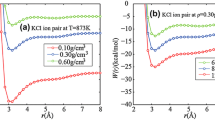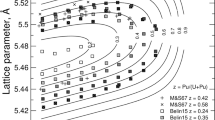Abstract
Modeling of mineral reaction equilibria and aqueous-phase speciation of C–O–H fluids requires the dielectric constant of the fluid mixture, which is not known from experiment and is typically estimated by some rule for mixing pure component values. In order to evaluate different proposed mixing rules, we use molecular dynamics simulation to calculate the dielectric constant of a model H2O–CO2 mixture at temperatures of 700 and 1000 K at pressures up to 3 GPa. We find that theoretically based mixing rules that depend on combining the molar polarizations of the pure fluids systematically overestimate the dielectric constant of the mixture, as would be expected for mixtures of nonpolar and strongly polar components. The commonly used semiempirical mixing rule due to Looyenga works well for this system at the lower pressures studied but somewhat underestimates the dielectric constant at higher pressures and densities, especially at the water-rich end of the composition range.




Similar content being viewed by others
References
Helgeson, H.C., Kirkham, D.H.: Theoretical prediction of the thermodynamic behavior of aqueous electrolytes at high pressures and temperatures: I. Summary of the thermodynamic/electrostatic properties of the solvent. Am. J. Sci. 274, 1089–1198 (1974)
Helgeson, H.C., Kirkham, D.H.: Theoretical prediction of the thermodynamic behavior of aqueous electrolytes at high pressures and temperatures: II. Debye-Hückel parameters for activity coefficients and relative partial molal properties. Am. J. Sci. 274, 1199–1261 (1974)
Helgeson, H.C., Kirkham, D.H.: Theoretical prediction of the thermodynamic behavior of aqueous electrolytes at high pressures and temperatures: III. Equation of state for aqueous species at infinite dilution. Am. J. Sci. 276, 97–240 (1976)
Helgeson, H.C., Kirkham, D.H., Flowers, G.C.: Theoretical prediction of the thermodynamic behavior of aqueous electrolytes at high pressures and temperatures: IV. Calculation of activity coefficients, osmotic coefficients, and apparent molal and standard and relative partial molal properties to 5 kb and 600 °C. Am. J. Sci. 281, 1241–1516 (1981)
Tanger, J.C., Helgeson, H.C.: Calculation of the thermodynamic and transport properties of aqueous species at high pressures and temperatures: revised equations of state for the standard partial molal properties of ions and electrolytes. Am. J. Sci. 288, 19–98 (1988)
Johnson, J.W., Oelkers, E.H., Helgeson, H.C.: SUPCRT92: a software package for calculating the standard molal thermodynamic properties of minerals, gases, aqueous species, and reactions from 1 to 5000 bars and 0 to 1000 °C. Comput. Geosci. 18, 899–947 (1992)
Shock, E.L., Oelkers, E.H., Johnson, J.W., Sverjensky, D.A., Helgeson, H.C.: Calculation of the thermodynamic and transport properties of aqueous species at high pressures and temperatures: effective electrostatic radii to 1000 °C and 5 kb. Faraday Soc. Trans. 88, 803–826 (1992)
Dolejš, D.: Thermodynamics of aqueous species at high temperatures and pressures: equations of state and transport theory. Rev. Miner. Geochem. 76, 35–79 (2013)
Dolejš, D., Manning, C.E.: Thermodynamic model for mineral solubility in aqueous fluids: theory, calibration and application to model fluid-flow systems. Geofluids 10, 20–40 (2010)
Manning, C.E.: Thermodynamic modeling of fluid–rock interaction at mid-crustal to upper-mantle conditions. Rev. Miner. Geochem. 76, 135–164 (2013)
Sverjensky, D.A., Harrison, B., Azzolini, D.: Water in the deep Earth: the dielectric constant and the solubilities of quartz and corundum to 60 kb and 1200 °C. Geochim. Cosmochim. Acta 129, 125–145 (2014)
Facq, S., Daniel, I., Montagnac, G., Cardon, H., Sverjensky, D.A.: In situ Raman study and thermodynamic model of aqueous carbonate speciation in equilibrium with aragonite under subduction zone conditions. Geochim. Cosmochim. Acta 132, 375–390 (2014)
Kerrick, D.M.: Review of metamorphic mixed volatile (CO2–H2O) equilibria. Am. Mineral. 54, 729–762 (1974)
Connolly, J.A.D., Cesare, B.: C-O–H–S fluid composition and oxygen fugacity in graphitic metapelites. J. Metamorph. Geol. 11, 379–388 (1993)
Huizenga, J.M.: Thermodynamic modeling of C–O–H fluids. Lithos 55, 101–114 (2001)
Zhang, C., Duan, Z.: A model for C-O–H fluid in the Earth’s mantle. Geochim. Cosmochim. Acta 73, 2089–2102 (2009)
Walther, J.V.: Ionic association in H2O–CO2 fluids at mid-crustal conditions. J. Metamorph. Geol. 10, 789–797 (1992)
Akinfiev, N., Zotov, A.: Thermodynamic description of equilibria in mixed fluids (H2O–non-polar gas) over a wide range of temperature (25–700 °C) and pressure (1–5000 bars). Geochim. Cosmochim. Acta 63, 2025–2041 (1999)
Galvez, M.E., Manning, C.E., Connolly, J.A.D., Rumble, D.: The solubility of rocks in metamorphic fluids: a model for rock-dominated conditions to upper mantle pressure and temperature. Earth Planet. Sci. Lett. 430, 486–498 (2015). doi:10.1016/j.epsl.2015.06.019
International Association for the Properties of Water and Steam: Release on the Static Dielectric Constant of Ordinary Water Substance for Temperatures from 238 K to 873 K and Pressures up to 1000 MPa (1997), http://www.iapws.org/relguide/Dielec.html. Acccessed 10 Oct 2015
Fernández, D.P., Goodwin, A.R.H., Lemmon, E.W., Levelt Sengers, J.M.H., Williams, R.C.: A formulation for the static permittivity of water and steam at temperatures from 238 K to 873 K at pressures up to 1200 MPa, including derivatives and Debye–Hückel coefficients. J. Phys. Chem. Ref. Data 26, 1125–1166 (1997)
Pan, D., Spanu, L., Harrison, B., Sverjensky, D.A., Galli, G.: Dielectric properties of water under extreme conditions and transport of carbonates in the deep Earth. Proc. Natl. Acad. Sci. 110, 6646–6650 (2013)
Harvey, A.H., Lemmon, E.W.: Method for estimating the dielectric constant of natural gas mixtures. Int. J. Thermophys. 26, 31–46 (2005)
Looyenga, H.: Dielectric constants of heterogeneous mixtures. Physica 31, 401–406 (1965)
Looyenga, H.: Dielectric constants of homogeneous mixtures. Mol. Phys. 9, 501–511 (1965)
Böttcher, C.J.F.: Theory of Electric Polarization, vol. 1, 2nd edn. Elsevier, Amsterdam (1973)
Kirkwood, J.G.: The dielectric polarization of polar liquids. J. Chem. Phys. 7, 911–919 (1939)
Oster, G.: The dielectric properties of liquid mixtures. J. Am. Chem. Soc. 68, 2036–2041 (1946)
Wang, P., Anderko, A.: Computation of dielectric constants of solvent mixtures and electrolyte solutions. Fluid Phase Equilib. 186, 103–122 (2001)
Orlov, A.G., Smirnov, S.N.: Determining the phase equilibrium parameters of a binary mixture with a polar component from its dielectric constant. Therm. Eng. 41, 650–654 (1994)
Harvey, A.H., Prausnitz, J.M.: Dielectric constants of fluid mixtures over a wide range of temperature and density. J. Solution Chem. 16, 857–869 (1987)
Berendsen, H.J.C., Grigera, J.R., Straatsma, T.P.: The missing term in effective pair potentials. J. Phys. Chem. 91, 6269–6271 (1987)
Zhang, Z., Duan, Z.: An optimized molecular potential for carbon dioxide. J. Chem. Phys. 122, 214507 (2005)
Pérez-Sánchez, G., González-Salgado, D., Piñiero, M.M., Vega, C.: Fluid–solid equilibrium of carbon dioxide as obtained from computer simulations of several popular potential models: the role of the quadrupole. J. Chem. Phys. 138, 084506 (2013)
Aimoli, C.G., Maginn, E.J., Abreu, C.R.A.: Force field comparison and thermodynamic property calculation of supercritical CO2 and CH4 using molecular dynamics simulations. Fluid Phase Equilib. 368, 80–90 (2014)
Potoff, J.J., Siepmann, J.I.: Vapor–liquid equilibria of mixtures containing alkanes, carbon dioxide, and nitrogen. AIChE J. 47, 1676–1682 (2001)
Duan, Z., Zhang, Z.: Equation of state of the H2O, CO2, and H2O–CO2 systems up to 10 GPa and 2573.15 K. Molecular dynamics simulations with ab initio potential surface. Geochim. Cosmochim. Acta 70, 2311–2324 (2006)
Hansen, J.P., McDonald, I.R.: Theory of Simple Liquids, 2nd edn, p. 179. Academic Press, New York (1986)
Kong, C.L.: Combining rules for intermolecular potential parameters: II. Rules for the Lennard-Jones (12–6) potential and the Morse potential. J. Chem. Phys. 59, 2464–2467 (1973)
Sangster, M.J.L., Dixon, M.: Interionic potentials in alkalai halides and their use in simulations of the molten salts. Adv. Phys. 25, 247–342 (1976)
Martyna, G.J., Tobias, D.J., Klein, M.L.: Constant pressure molecular dynamics algorithms. J. Chem. Phys. 101, 4177–4189 (1994)
Martys, N.S., Mountain, R.D.: Velocity Verlet algorithm for dissipative-particle-dynamics-based models of suspensions. Phys. Rev. E 59, 3733–3736 (1999)
Evans, D.J., Murad, S.: Singularity free algorithm for molecular dynamics simulation of rigid polyatomics. Mol. Phys. 34, 327–331 (1977)
Hogg, R.V., McKean, J.W., Craig, A.T.: Introduction to Mathematical Statistics, 6th edn. Pearson Prentice Hall, Upper Saddle River (2005)
Russell, A.J., Spackman, M.A.: Vibrational averaging of electrical properties. Development of a routine theoretical method for polyatomic molecules. Mol. Phys. 84, 1239–1255 (1995)
Allen, M.P., Tildesley, D.J.: Computer Simulation of Liquids, p. 163. Clarendon Press, Oxford (1987)
Wagner, W., Pruß, A.: The IAPWS formulation 1995 for the thermodynamic properties of ordinary water substance for general and scientific use. J. Phys. Chem. Ref. Data 31, 387–535 (2002)
International Association for the Properties of Water and Steam: Revised Release on the IAPWS Formulation 1995 for the Thermodynamic Properties of Ordinary Water Substance for General and Scientific Use (2014), http://www.iapws.org/relguide/IAPWS-95.html. Accessed 10 October 2015
Tödheide, K., Franck, E.U.: Das Zweiphasengebiet und die kritische Kurve im System Kohlendioxid-Wasser bis zu Drucken von 3500 bar. Z. Phys. Chem. Neue Folge 37, 387–401 (1963)
Mather, A.E., Franck, E.U.: Phase equilibria in the system carbon dioxide–water at elevated pressures. J. Phys. Chem. 96, 6–8 (1992)
Holland, R., Powell, R.: Activity–composition relations for phases in petrological calculations: an asymmetric multicomponent formulation. Contrib. Miner. Petrol. 145, 492–501 (2003)
Span, R., Wagner, W.: A new equation of state for carbon dioxide covering the fluid region from the triple-point temperature to 1100 K at pressures up to 800 MPa. J. Phys. Chem. Ref. Data 25, 1509–1596 (1996)
Botti, A., Bruni, F., Mancinelli, R., Ricci, M.A., Lo Celso, F., Triolo, R., Ferrante, F., Soper, A.K.: Study of percolation and clustering in supercritical water–CO2 mixtures. J. Chem. Phys. 128, 164504 (2008)
Acknowledgments
We thank Dr. Matthieu Galvez for bringing this problem to our attention and for helpful comments during the course of the work.
Author information
Authors and Affiliations
Corresponding author
Additional information
Contribution of the National Institute of Standards and Technology, not subject to copyright in the United States.
Rights and permissions
About this article
Cite this article
Mountain, R.D., Harvey, A.H. Molecular Dynamics Evaluation of Dielectric Constant Mixing Rules for H2O–CO2 at Geologic Conditions. J Solution Chem 44, 2179–2193 (2015). https://doi.org/10.1007/s10953-015-0401-6
Received:
Accepted:
Published:
Issue Date:
DOI: https://doi.org/10.1007/s10953-015-0401-6




